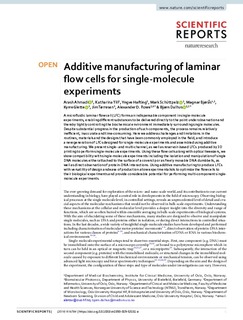| dc.contributor.author | Ahmadi, Arash | |
| dc.contributor.author | Till, Katharina | |
| dc.contributor.author | Hafting, Yngve | |
| dc.contributor.author | Schuttpelz, Mark | |
| dc.contributor.author | Bjørås, Magnar | |
| dc.contributor.author | Glette, Kyrre | |
| dc.contributor.author | Tørresen, Jim | |
| dc.contributor.author | Rowe, Alexander D. | |
| dc.contributor.author | Dalhus, Bjørn | |
| dc.date.accessioned | 2020-01-23T07:22:08Z | |
| dc.date.available | 2020-01-23T07:22:08Z | |
| dc.date.created | 2019-12-10T13:39:27Z | |
| dc.date.issued | 2019 | |
| dc.identifier.citation | Scientific Reports. 2019, 9 (1), 1-12. | nb_NO |
| dc.identifier.issn | 2045-2322 | |
| dc.identifier.uri | http://hdl.handle.net/11250/2637541 | |
| dc.description.abstract | A microfluidic laminar flow cell (LFC) forms an indispensable component in single-molecule experiments, enabling different substances to be delivered directly to the point under observation and thereby tightly controlling the biochemical environment immediately surrounding single molecules. Despite substantial progress in the production of such components, the process remains relatively inefficient, inaccurate and time-consuming. Here we address challenges and limitations in the routines, materials and the designs that have been commonly employed in the field, and introduce a new generation of LFCs designed for single-molecule experiments and assembled using additive manufacturing. We present single- and multi-channel, as well as reservoir-based LFCs produced by 3D printing to perform single-molecule experiments. Using these flow cells along with optical tweezers, we show compatibility with single-molecule experiments including the isolation and manipulation of single DNA molecules either attached to the surface of a coverslip or as freely movable DNA dumbbells, as well as direct observation of protein-DNA interactions. Using additive manufacturing to produce LFCs with versatility of design and ease of production allow experimentalists to optimize the flow cells to their biological experiments and provide considerable potential for performing multi-component single-molecule experiments. | nb_NO |
| dc.language.iso | eng | nb_NO |
| dc.publisher | Nature Research | nb_NO |
| dc.rights | Navngivelse 4.0 Internasjonal | * |
| dc.rights.uri | http://creativecommons.org/licenses/by/4.0/deed.no | * |
| dc.title | Additive manufacturing of laminar flow cells for single-molecule experiments | nb_NO |
| dc.type | Journal article | nb_NO |
| dc.type | Peer reviewed | nb_NO |
| dc.description.version | publishedVersion | nb_NO |
| dc.source.pagenumber | 1-12 | nb_NO |
| dc.source.volume | 9 | nb_NO |
| dc.source.journal | Scientific Reports | nb_NO |
| dc.source.issue | 1 | nb_NO |
| dc.identifier.doi | 10.1038/s41598-019-53151-z | |
| dc.identifier.cristin | 1758870 | |
| dc.relation.project | Norges forskningsråd: 281255 | nb_NO |
| dc.description.localcode | Open Access This article is licensed under a Creative Commons Attribution 4.0 International License, which permits use, sharing, adaptation, distribution and reproduction in any medium or format, as long as you give appropriate credit to the original author(s) and the source, provide a link to the Creative Commons license, and indicate if changes were made. The images or other third party material in this article are included in the article’s Creative Commons license, unless indicated otherwise in a credit line to the material. If material is not included in the article’s Creative Commons license and your intended use is not permitted by statutory regulation or exceeds the permitted use, you will need to obtain permission directly from the copyright holder. To view a copy of this license, visit http://creativecommons.org/licenses/by/4.0/. | nb_NO |
| cristin.unitcode | 194,65,15,0 | |
| cristin.unitname | Institutt for klinisk og molekylær medisin | |
| cristin.ispublished | true | |
| cristin.fulltext | original | |
| cristin.qualitycode | 1 | |

